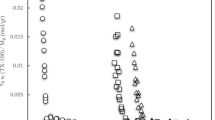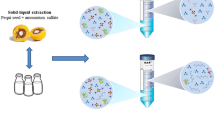Abstract
The response surface methodology (RSM) was utilized to optimize three-phase partitioning (TPP) parameters for the purification of Calotropis gigantea latex protease. The limits of purification parameters namely saturation of ammonium sulfate salt, volume ratio of tert-butanol to crude latex extract and pH value were selected from single-factor experiments. A Box-Behnken design was employed to determine the effects of TPP parameters on protease purification. From the optimization study, the degree of purification and recovery percentage reached maximum values of 6.7 and 126.12%, respectively, under optimized parameters of 52% saturation of (NH4)2SO4 (w/v), 1.0:1.5 ratio of crude latex extract to tert-butanol (v/v) and pH 6. The concentrated protease in the interfacial phase (IP) demonstrated higher enzyme activity when compared to the lower aqueous phase (AP). The molecular weight of recovered protease was 24 kDa from electrophoretic analysis, and the substrate zymography revealed the presence of protease in IP fraction. The findings of this study demonstrated that TPP is an effective and economic protocol for quick recovery of latex protease in comparison with expensive and time-consuming chromatographic techniques.





Similar content being viewed by others
References
Abraham KI, Joshi PN (1979) Studies on proteinases from Calotropis gigantea latex. Purification and some properties of two proteinases containing carbohydrate. Biochem Biophys Acta 568(1):111–119. https://doi.org/10.1016/0005-2744(79)90278-x
Box GEP, Hunter JS, Hunter WG (2005) Statistics for experimenters: design, innovation, and discovery. John Wiley & Sons
Bradford MM (1976) A rapid and sensitive method for the quantitation of microgram quantities of protein utilizing the principle of protein-dye binding. Anal Biochem 72(1):248–254. https://doi.org/10.1016/0003-2697(76)90527-3
Chaiwut P, Pintathong P, Rawdkuen S (2010) Extraction and three-phase partitioning behavior of proteases from papaya peels. Process Biochem 45(7):1172–1175. https://doi.org/10.1016/j.procbio.2010.03.019
Chen X, Cai C, Tan Z (2022) Deep eutectic solvents-based three-phase partitioning for tomato peroxidase purification: a promising method for substituting t-butanol. Food Chem 393:133379. https://doi.org/10.1016/j.foodchem.2022.133379
Chew KW, Ling TC, Show PL (2019) Recent developments and applications of three-phase partitioning for the recovery of proteins. Sep Purif Rev 48(1):52–64. https://doi.org/10.1080/15422119.2018.1427596
Dennison C (2011) Three-phase partitioning. In: Methods in protein biochemistry, Tschesche H (ed), De Gruyter, pp 1–12
Dennison C, Lovrien R (1997) Three phase partitioning: concentration and purification of proteins. Protein Expr Purif 11(2):149–161. https://doi.org/10.1006/prep.1997.0779
Diamond AD, Hsu JT (1992) Aqueous two-phase systems for biomolecule separation. In: Tsao GT (ed) Bioseparation. Springer, Berlin Heidelberg, pp 89–135
Dong L, He L, Huo D (2020) Three phase partitioning as a rapid and efficient method for purification of plant-esterase from wheat flour. Pol J Chem Technol 22(2):42–49. https://doi.org/10.2478/pjct-2020-0015
Gagaoua M, Hafid K (2016) Three phase partitioning system, an emerging non-chromatographic tool for proteolytic enzymes recovery and purification. Biosens J. https://doi.org/10.4172/2090-4967.1000134
Gagaoua M, Boucherba N, Bouanane-Darenfed A, Ziane F, Nait-Rabah S, Hafid K, Boudechicha H-R (2014) Three-phase partitioning as an efficient method for the purification and recovery of ficin from Mediterranean fig (Ficus carica L.) latex. Separ Purif Technol 132:461–467. https://doi.org/10.1016/j.seppur.2014.05.050
Gagaoua M, Hoggas N, Hafid K (2015) Three phase partitioning of zingibain, a milk-clotting enzyme from Zingiber officinale Roscoe rhizomes. Int J Biol Macromol 73:245–252. https://doi.org/10.1016/j.ijbiomac.2014.10.069
Gagaoua M, Hafid K, Hoggas N (2016) Data in support of three phase partitioning of zingibain, a milk-clotting enzyme from Zingiber officinale Roscoe rhizomes. Data Brief 6:634–639. https://doi.org/10.1016/j.dib.2016.01.014
Gagaoua M, Ziane F, Nait Rabah S, Boucherba N, Ait Kaki El-Hadef El-Okki A, Bouanane-Darenfed A, Hafid K (2017) Three phase partitioning, a scalable method for the purification and recovery of cucumisin, a milk-clotting enzyme, from the juice of Cucumis melo var. reticulatus. Int J Biol Macromol 102:515–525. https://doi.org/10.1016/j.ijbiomac.2017.04.060
Gagaoua M (2018) Aqueous methods for extraction/recovery of macromolecules from microorganisms of atypical environments: a focus on three phase partitioning. In: Microbiology of Atypical Environments, Methods in Microbiology, pp 203–242
Gagaoua M (2021) Enzymes recovery by three phase partitioning. In: Three Phase Partitioning, pp 79–110
Garg R, Thorat BN (2014) Nattokinase purification by three phase partitioning and impact of t-butanol on freeze drying. Sep Purif Technol 131:19–26. https://doi.org/10.1016/j.seppur.2014.04.011
Grozdanovic MM, Burazer L, Gavrovic-Jankulovic M (2013) Kiwifruit (Actinidia deliciosa) extract shows potential as a low-cost and efficient milk-clotting agent. Int Dairy J 32(1):46–52. https://doi.org/10.1016/j.idairyj.2013.03.001
Gul A, Khan S, Arain H, Khan H, Ishrat U, Siddiqui M (2022) Three-phase partitioning as an efficient one-step method for the extraction and purification of bromelain from pineapple crown waste. J Food Process Preserv. https://doi.org/10.1111/jfpp.16973
Hafid K, John J, Sayah TM, Dominguez R, Becila S, Lamri M, Dib AL, Lorenzo JM, Gagaoua M (2020) One-step recovery of latex papain from Carica papaya using three phase partitioning and its use as milk-clotting and meat-tenderizing agent. Int J Biol Macromol 146:798–810. https://doi.org/10.1016/j.ijbiomac.2019.10.048
Kadiyala M, Ponnusankar S, Elango K (2013) Calotropis gigantiea (L.) R. Br (Apocynaceae): a phytochemical and pharmacological review. J Ethnopharmacol 150(1):32–50. https://doi.org/10.1016/j.jep.2013.08.045
Kiss É, Szamos J, Tamás B, Borbás R (1998) Interfacial behavior of proteins in three-phase partitioning using salt-containing water/tert-butanol systems. Colloids Surf, A 142(2):295–302. https://doi.org/10.1016/S0927-7757(98)00361-6
Kumar VV, Sathyaselvabala V, Kirupha SD, Murugesan A, Vidyadevi T, Sivanesan S (2011) Application of response surface methodology to optimize three phase partitioning for purification of laccase from Pleurotus ostreatus. Sep Sci Technol 46(12):1922–1930. https://doi.org/10.1080/01496395.2011.583306
Kumar Dubey V, Jagannadham MV (2003) Procerain, a stable cysteine protease from the latex of Calotropis procera. Phytochemistry 62(7):1057–1071. https://doi.org/10.1016/S0031-9422(02)00676-3
Lad S, Rao PS, Vikhe DN (2021) Calotropis Gigantea- a review. Res J Sci Tech 13(4):261–264. https://doi.org/10.52711/2349-2988.2021.00041
Ladd JN, Butler JHA (1972) Short-term assays of soil proteolytic enzyme activities using proteins and dipeptide derivatives as substrates. Soil Biol Biochem 4:19–30. https://doi.org/10.1016/0038-0717(72)90038-7
Maskey B, Karki DB (2023) Efficient three phase partitioning of actinidin from kiwifruit (Actinidia deliciosa) and its characterization. Prep Biochem Biotechnol. https://doi.org/10.1080/10826068.2023.2209877
Özer B, Akardere E, Çelem EB, Önal S (2010) Three-phase partitioning as a rapid and efficient method for purification of invertase from tomato. Biochem Eng J 50(3):110–115. https://doi.org/10.1016/j.bej.2010.04.002
Pal G, Sinha NK (1980) Isolation, crystallization, and properties of calotropins DI and DII from Calotropis gigantea. Arch Biochem Biophys 202(2):321–329. https://doi.org/10.1016/0003-9861(80)90434-8
Pike RN, Dennison C (1989) Protein fractionation by three phase partitioning (TPP) in aqueous/t-butanol mixtures. Biotechnol Bioeng 33(2):221–228. https://doi.org/10.1002/bit.260330213
Rajagopalan A, Sukumaran BO (2018) Three phase partitioning to concentrate milk clotting proteases from Wrightia tinctoria R. Br and its characterization. Int J Biol Macromol 118(Pt A):279–288. https://doi.org/10.1016/j.ijbiomac.2018.06.042
Rajagopalan A, Soundararajan M, Sukumaran BO (2018) Proteases from Calotropis gigantea stem, leaf and calli as milk coagulant source. Turk J Biochem 44:240–247. https://doi.org/10.1515/tjb-2017-0268
Rawdkuen S, Chaiwut P, Pintathong P, Benjakul S (2010) Three-phase partitioning of protease from Calotropis procera latex. Biochem Eng J 50(3):145–149. https://doi.org/10.1016/j.bej.2010.04.007
Rawdkuen S, Vanabun A, Benjakul S (2012) Recovery of proteases from the viscera of farmed giant catfish (Pangasianodon gigas) by three-phase partitioning. Process Biochem 47(12):2566–2569. https://doi.org/10.1016/j.procbio.2012.09.001
Schagger H (2006) Tricine-SDS-PAGE. Nat Protoc 1(1):16–22. https://doi.org/10.1038/nprot.2006.4
Sengupta A, Bhattacharya D, Pal G, Sinha NK (1984) Comparative studies on Calotropins DI and DII from the Latex of Calotropis Gigantea. Archiv Biochem Biophys 232(1):17–25. https://doi.org/10.1016/0003-9861(84)90517-4
Sharma A, Gupta MN (2004) Oil extraction from almond, apricot and rice bran by three-phase partitioning after ultrasonication. Eur J Lipid Sci Technol 106(3):183–186. https://doi.org/10.1002/ejlt.200300897
Singh RK, Gourinath S, Sharma S, Roy I, Gupta MN, Betzel C, Srinivasan A, Singh TP (2001) Enhancement of enzyme activity through three-phase partitioning: crystal structure of a modified serine proteinase at 1.5 Å resolution. Protein Eng Des Select 14(5):307–313. https://doi.org/10.1093/protein/14.5.307(acccessed3/28/2023)
Singh AN, Shukla AK, Jagannadham MV, Dubey VK (2010) Purification of a novel cysteine protease, procerain B, from Calotropis procera with distinct characteristics compared to procerain. Process Biochem 45(3):399–406. https://doi.org/10.1016/j.procbio.2009.10.014
Tan KH, Lovrien R (1972) Enzymology in aqueous-organic cosolvent binary mixtures. J Biol Chem 247(10):3278–3285. https://doi.org/10.1016/S0021-9258(19)45242-3
Wang Z-N, Wang M-Y, Mei W-L, Han Z, Dai H-F (2008) A new cytotoxic pregnanone from Calotropis Gigantea. Molecules 13(12):3033–3039. https://doi.org/10.3390/molecules13123033
Yan JK, Wang YY, Qiu WY, Ma H, Wang ZB, Wu JY (2018) Three-phase partitioning as an elegant and versatile platform applied to nonchromatographic bioseparation processes. Crit Rev Food Sci Nutr 58(14):2416–2431. https://doi.org/10.1080/10408398.2017.1327418
Acknowledgements
We would like to thank Central Department of Food Technology, Dharan, Nepal; and Central Campus of Technology, Dharan, Nepal for all their support. We especially thank to Dr. Mohammed Gagaoua, Researcher at French National Institute for Agriculture, Food, and Environment (INRAE), France; Dr. Anusha Rajagopalan, Research Associate at Central Institute of Freshwater Aquaculture, India; and Dr. Sarita Shrestha, Lakehead University, Canada. We also thank to Bhawana Sharma Ghimire, Megha Shrestha, Pratikshya Pokhrel and Peshal Raj Karki for their help in this study.
Funding
This research work was supported by University Grants Commission, Nepal (Award Number: PhD-75/76-S&T-7).
Author information
Authors and Affiliations
Corresponding author
Ethics declarations
Conflict of interest
The authors declare that they do not have any conflict of interest.
Additional information
Publisher's Note
Springer Nature remains neutral with regard to jurisdictional claims in published maps and institutional affiliations.
Rights and permissions
Springer Nature or its licensor (e.g. a society or other partner) holds exclusive rights to this article under a publishing agreement with the author(s) or other rightsholder(s); author self-archiving of the accepted manuscript version of this article is solely governed by the terms of such publishing agreement and applicable law.
About this article
Cite this article
Maskey, B., Karki, D.B. & Shrestha, N.K. Optimization of three-phase partitioning system for the purification of protease from Calotropis gigantea latex using response surface methodology. Chem. Pap. 78, 2549–2559 (2024). https://doi.org/10.1007/s11696-023-03259-4
Received:
Accepted:
Published:
Issue Date:
DOI: https://doi.org/10.1007/s11696-023-03259-4




